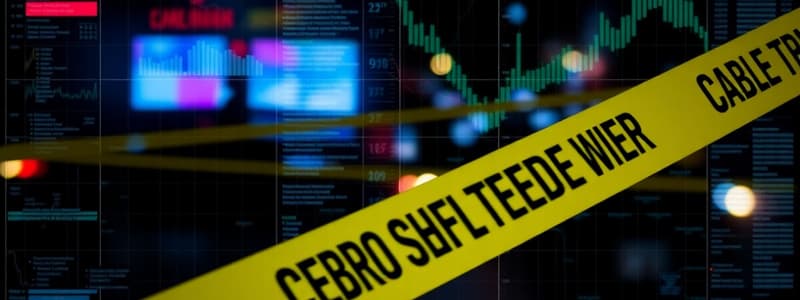Podcast
Questions and Answers
Match the types of crime patterns with their descriptions:
Match the types of crime patterns with their descriptions:
Series = A group of similar crimes thought to be committed by the same bunch Spree = Many crimes committed in a short period Hot prey = Crimes involving victims who share similar characteristics Hot product = Crimes targeting a unique type of property for theft
Match the crime analysis types with their focus periods:
Match the crime analysis types with their focus periods:
Tactical analysis = 24 hours to three months Strategic analysis = Three months to a decade or longer Pattern analysis = Identification of similarities in crime cases Weighted Time Span Analysis = Identifying trends over various timeframes
Match the analysis methods with their descriptions:
Match the analysis methods with their descriptions:
Frequency distribution = Shows the frequency of values in a dataset Crosstab = A table showing the relationship between variables Trend comparisons = Assessing relevance against other categories Percentage conversion = Highlighting hot spots by converting frequencies
Match the definitions with the crime analysis terms:
Match the definitions with the crime analysis terms:
Match the crime characteristics with their types:
Match the crime characteristics with their types:
Match the crime analysis tools with their purposes:
Match the crime analysis tools with their purposes:
Match the elements of crime frequency analysis with their outcomes:
Match the elements of crime frequency analysis with their outcomes:
Match the roles of analysts with their tasks:
Match the roles of analysts with their tasks:
Match the following crime analysis types with their respective time frames:
Match the following crime analysis types with their respective time frames:
Match the following concepts with their definitions:
Match the following concepts with their definitions:
Match the following terms with their meanings:
Match the following terms with their meanings:
Match the following theories to their focus area:
Match the following theories to their focus area:
Match the following crime analysis methods with their focuses:
Match the following crime analysis methods with their focuses:
Match the following crime concepts with their characteristics:
Match the following crime concepts with their characteristics:
Match the following terms to their definitions in crime analysis:
Match the following terms to their definitions in crime analysis:
Match the following phrases with their related concepts:
Match the following phrases with their related concepts:
What is the primary objective of pattern analysis in crime data?
What is the primary objective of pattern analysis in crime data?
Which of the following best defines a 'hot prey' crime pattern?
Which of the following best defines a 'hot prey' crime pattern?
In frequency distribution analysis, what is the primary purpose of converting frequency values into percentages?
In frequency distribution analysis, what is the primary purpose of converting frequency values into percentages?
What does the clearance rate measure in the context of crime analysis?
What does the clearance rate measure in the context of crime analysis?
Which type of analysis focuses on identifying short-term crime trends?
Which type of analysis focuses on identifying short-term crime trends?
How does seasonality affect crime frequency analysis?
How does seasonality affect crime frequency analysis?
What is the purpose of trend comparisons in crime analysis?
What is the purpose of trend comparisons in crime analysis?
Which of the following best summarizes the MO summary in pattern analysis?
Which of the following best summarizes the MO summary in pattern analysis?
What is characterized by a decrease in the number of days between incidents?
What is characterized by a decrease in the number of days between incidents?
Which type of crime analysis focuses on long-term reduction objectives and utilizes data that spans from three months to decades?
Which type of crime analysis focuses on long-term reduction objectives and utilizes data that spans from three months to decades?
In the context of the crime triangle, what can a 'place' refer to?
In the context of the crime triangle, what can a 'place' refer to?
What does the law of crime concentration state about crime occurrences?
What does the law of crime concentration state about crime occurrences?
What theory suggests that offenders are likely to commit crimes in familiar locations?
What theory suggests that offenders are likely to commit crimes in familiar locations?
Which of the following is NOT an aspect of crime analysis?
Which of the following is NOT an aspect of crime analysis?
What is the overarching purpose of crime analysis?
What is the overarching purpose of crime analysis?
In Routine Activities Theory, which elements are essential in the crime triangle?
In Routine Activities Theory, which elements are essential in the crime triangle?
Flashcards are hidden until you start studying
Study Notes
Tactical Crime Analysis
- Tactical analysts work with data sets covering a period of 2 weeks.
- Pattern identification involves collecting information from various sources to identify similarities among crimes.
- Commonality: Exact matches between crime patterns.
- Similarity: Close matches between crime patterns.
- Clearance rate measures the success of solving crimes (number of cases cleared/total number of cases x 100).
- MO Summary is a form of pattern analysis that manually synthesizes information from various sources (occurrence reports, tips, social media) to understand the "who, what, where, and how" of a crime.
Crime Pattern Types
- Series: A group of similar crimes believed to be committed by the same offender.
- Spree: A series of crimes committed in a short period, often involving violence (killing spree).
- Hot Prey: Crimes targeting victims with specific characteristics and behaviors (e.g., gang killings).
- Hot Product: Crimes targeting specific types of property (e.g., espionage).
- Hot Place: Crimes committed in a specific location.
Analyzing Crime Frequency
- Tactical analysts focus on short-term trends (24 hours to 3 months), while strategic analysts examine long-term trends (3 months to decades).
- Two primary methods for analyzing crime frequency:
- Frequency Distribution: Analyzing the occurrence of values within a dataset based on predetermined categories.
- Crosstabulation: Examining the relationship between two or more variables.
- Data is often grouped by week or month to identify longer-term patterns.
- This information is valuable for crime reduction measures, resource allocation, and policy formulation.
Weighted Time Span Analysis
- Analyzes temporal patterns between crimes in series.
- Considers factors like seasonality, weather, school attendance, and work schedules, which can influence crime frequency.
Trend Comparisons
- Comparing trends across crime categories, different jurisdictions, or other relevant factors provides valuable insights.
- Temporal intervals can be categorized as:
- Accelerating: Decreasing time between incidents.
- Decelerating: Increasing time between incidents.
- Constant: Consistent time between incidents.
- Random: No discernible pattern.
- Tempogram: Graphical representation of temporal intervals between crime events in a series.
Strategic Crime Analysis
- Focuses on long-term crime reduction strategies.
- Utilizes both primary and secondary data sources to understand the context of crime events.
- Primary data: Directly collected information (e.g., police reports).
- Secondary data: Existing data from other sources (e.g., census data).
Traditional vs. Environmental Criminology
- Traditional Criminology: Examines biological, psychological, and sociological factors to understand why individuals become criminals.
- Environmental Criminology: Focuses on the situational factors that contribute to crime.
- Analyzes how specific environments create opportunities for crime.
Crime Triangle
- Identifies the essential elements that contribute to criminal activity:
- Offender: The perpetrator of the crime.
- Target/Victim: The person or object targeted by the crime.
- Place: The location of the crime.
Routine Activities Theory
- Crimes occur when the activity spaces of potential offenders and potential victims/targets overlap.
- Offenders often commit crimes within or close to familiar locations.
- Pareto Principle: A small number of locations account for a large proportion of crime events (80/20 rule).
- Law of Crime Concentration: 50% of crime is concentrated in a small percentage of locations.
True Repeats
- Occurs when a target is victimized on multiple occasions by the same type of crime, likely by the same offender.
- Example: A person being assaulted multiple times at the same location.
Tactical Analysis & Pattern Identification
- Tactical analysts use data from the past two weeks to identify patterns.
- Pattern analysis involves grouping similar cases based on similarities and commonalities.
- Commonalities indicate exact matches, while similarities indicate close matches within a crime pattern area.
- Clearance rate measures the success of solving crimes. This is calculated by dividing the number of cleared cases by the total number of cases and then multiplying by 100.
- An MO summary is a type of pattern analysis that involves combining information from various sources like occurrence reports, tips, and social media.
Types of Crime Patterns
- Series: A group of similar crimes likely committed by the same offender.
- Spree: A series of crimes committed in a short period, often involving violence, usually classified as a killing spree.
- Hot Prey: Crimes targeting individuals with shared characteristics and behaviors, such as gang killings.
- Hot Product: Crimes involving the theft of specific types of property, such as espionage.
- Hot Place: Crimes concentrated in a particular location, often committed by the same offender or group.
Analyzing Crime Frequency
- Tactical analysts analyze crime frequency within 24 hours to three months to identify short-term trends.
- Strategic analysts analyze data for three months to a decade or longer to identify long-term trends.
- Frequency Distribution: A method for visualizing trends by grouping data into categories and analyzing the frequency of occurrences within those categories.
- Crosstabulation: A table that displays the relationship between multiple variables, aiding in trend analysis.
- Grouping frequency by week and month helps detect longer-term patterns in crime frequency.
Weighted Time Span Analysis
- Seasonality: The influence of factors like weather, school attendance, and work schedules on crime frequency.
Trend Comparisons
- Comparing monthly or yearly trends to other crime categories, other jurisdictions, or other relevant benchmarks helps in assessing the significance of the observed trend.
Temporal Intervals
- Accelerating: Decreases in the time between incidents.
- Decelerating: Increases in the time between incidents.
- Constant: Stable intervals between incidents.
- Random: No discernible recurring pattern.
- Tempogram: A visual representation of the temporal intervals between crimes in a series.
Crime Analysis: The Big Picture
- Overarching Purpose: To improve safety and security by reducing crime.
- Crime Prevention: Proactive measures to eliminate opportunities or discourage criminal activity.
- Crime Analysis: Not involved in crime scene investigation, forensic profiling, or analysis of physical evidence.
Tactical vs. Strategic Crime Analysis
- Tactical Crime Analysis: Short-term analysis (24 hours to 3 months) to provide immediate support for cases.
- Strategic Crime Analysis: Long-term (3 months to decades) analysis focused on crime reduction objectives. Utilizes primary and secondary data, facts, and theories.
Criminological Perspectives
- Traditional Criminology: Examines the biological, psychological, and sociological factors that contribute to criminal behavior.
- Environmental Criminology: Focuses on the situational factors that influence crime occurrence rather than the individual motivations of offenders.
- Crime Triangle: A model that emphasizes the interplay between the offender, the target/victim, and the place, emphasizing the role of opportunity in crime.
Routine Activities Theory and the Crime Pattern Theory
- Routine Activities Theory: Suggests that crime occurs when motivated offenders, suitable targets, and a lack of capable guardianship converge.
- Crime Pattern Theory: A central concept in environmental criminology, it proposes that crime opportunities arise when the activity spaces of potential offenders and victims overlap.
- Offenders: Tend to commit crimes in areas familiar to them.
- Pareto Principle (80/20 Rule): A small number of places account for a large proportion of crime.
- Law of Crime Concentration: A specific location accounts for a significant percentage of crimes.
Repetitive Crimes
- True-repeats: The same target is victimized multiple times by the same crime type.
Studying That Suits You
Use AI to generate personalized quizzes and flashcards to suit your learning preferences.




